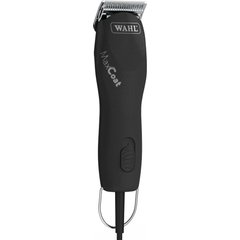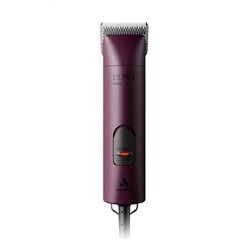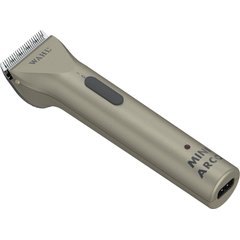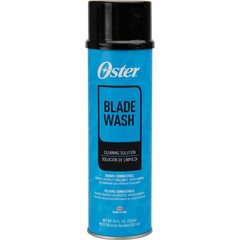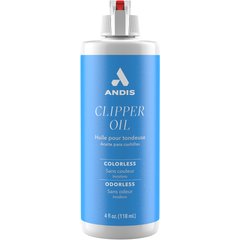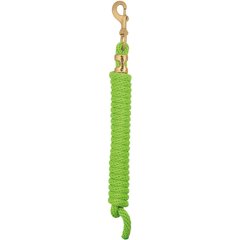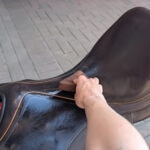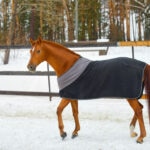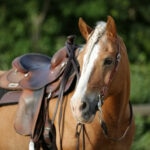How To Choose and Care for Horse Clippers

Photo by daniele russo/iStock/Getty Images Plus
Many horse owners choose to have their horse’s body clipped in warm weather to help keep them cool, or in cold weather to help regulate their body temperature while working.
It’s important to do your research when purchasing horse clippers, so you can achieve the best results.
Key Takeaways
- Horses are often more comfortable being regularly ridden in the winter when some or all of their body hair is clipped.
- The best equine clippers have a powerful motor and detachable blades of varying coarseness.
- Keep your clipper blades sharp, clean, cool, and lubricated during clipping sessions for best results.
- Introduce your horse to clippers slowly, and don’t be afraid to ask for assistance with holding your horse for their clipping session, rather than tying them.
Choosing the Right Horse Clippers
Selecting the best horse clippers depends on your unique horse’s coat type and needs.
Types of Equine Clippers
Heavy-duty clippers are substantial machines, and a bit unwieldy for faces but ideal for body clipping a thick coat. The powerful motor and bigger blades save time and effort, and are more comfortable for the horse.
Heavy-duty clippers are necessary if you’ll be clipping more than one horse in a session, or if your horse has a thick coat. They’re generally not used for legs or faces.
Check out the Wahl MaxCoat Horse Clipper as a great option.
Recommended Product
Medium-duty clippers are smaller than heavy-duty clippers, but still contain a powerful motor and sharp detachable blades. They are useful for clipping faces, noses, ears, and hooves, as well as bridle paths.
The right pair with wide blades can also do body clipping on a very clean horse, and are ideal for less arm fatigue.
A great medium-duty clipper is the Andis UltraEdge AGC Super 2-Speed.
Recommended Product
Trimmers are small, lightweight clippers with smaller blades. They are inexpensive, easy to transport and use, and best for touch-ups of previously clipped faces, whiskers (note: some showing organizations do not allow trimming of whiskers), and the longer hairs around the eyes. They’re usually not powerful enough for cutting a new bridle path or heavy leg hair.
The Wahl Mini Arco Trimmer is a solid choice for quick trimming.
Recommended Product
Power Source Options
Corded clippers supply plenty of power for more than one clipping job, but can limit where you can clip your horse to a spot near an outlet, and cords can spook some horses.
Heavy-duty clippers can also have a handle with blades corded to a separate power source, which is ideal for groomers with sensitive wrists.
Cordless horse clippers are ideal for smaller jobs like trimming around your horse’s hooves or ears. They’re easy to use anywhere—no access to an outlet needed.
The downside to cordless is the higher cost due to needing a powerful battery that lasts long enough to clip your horse.
Blade Options
The type of clippers you choose is important, but the blades are key to getting the results you want.
Fine blades such as 30s and 40s shave too close for most uses—they’ll remove hair down to the skin and can cut the horse if you’re not careful.
Recommended Products
Save these for surgical jobs or specialty face clipping, such as for Arabian or Saddlebred competition.
Coarse blades are better for most clipping jobs. Try using a size 8 or 10.
Recommended Product
Fixed blades can’t be removed and are not recommended for horses. Detachable blades are preferred because they can be more easily maintained.
Although blade guards are useful in human and dog clippers, don’t use them for horses. Instead, choose the appropriate blade coarseness.
A T-84 blade is great for most jobs, from body clipping to ears and legs.
Key Clipper Features To Consider
Some features can extend the life of your clippers, make each clipping job more efficient and comfortable for your horse, and make your work a little easier. These include:
- Powerful motor that is durable and reliable
- Cooling mechanisms, such as air vents, fans, and self-cooling blades
- Properly adjusted blades, which lower noise and vibration
Clipper Budget and Brand Reputation
With clippers, making an investment in quality will pay off in the long run, especially if you have a lot of horses to clip regularly or you do body clipping professionally. If you’re occasionally doing light clipping of ears, noses, and coronary bands, you can choose a more cost-effective pair.
“If you’re going to be body clipping your own horses, make sure that you’re dropping a good amount of money for a pair of clippers that are going to last you multiple seasons,” says Jess Raphael, a professional body clipper in Aurora, Colorado. “You don’t want to be buying a new pair every year. I have a pair I have used for the last eight years. I body clip eight horses a season, and they’re still going strong.”
It’s also a good idea to check for a warranty for your clippers. This can help preserve your investment in the machine.
Caring for Horse Clippers
You can purchase the highest quality clippers and blades, but if you don’t properly care for them, they’ll break down much sooner than if you clean, oil, and maintain them every time you use them.
You’ll want to start by reading your clippers’ manual for directions on care.
Before Use
Check your clipper blades to make sure they’re clean and sharp. Brush the blades to remove any hair. Dip them in Blade Wash to keep them clean and lubricated from the start.
Recommended Product
Ensure blades are sharp and clean, and oil the blades to reduce friction and overheating.
Recommended Product
Check clipper cords or battery charge to ensure you’re ready to start.
During Use
Karen Banister, APHA, AQHA, USEF/USHJA trainer and multi-association carded judge, recommends pouring two inches of blade wash into a shallow dish and cleaning your clippers by dipping them in the solution every few minutes during your clipping job.
You’ll also want to regularly brush away hair trimmings on the blade, clippers, and vent.
If your blades get too hot, consider switching them out for another set if you’re in the middle of a body clip.
“We’ll clip, then brush, then dip them,” says Banister, who lives in Brighton, Colorado. “When the blades get hot, I will switch blades—and the blades that got hot, if still sharp, will sit in an alcohol bath to disinfect them.”
After Use
Separate the blades from the machine and remove any accumulated hair and dirt. Disinfect them in alcohol, oil them, and reassemble.
Don’t forget to dispose of your used blade wash and alcohol bath—they shouldn’t be reused.
Once they’re dry, store your blades in a clean, dry place. It’s best to pack them in the clippers case in a tack room, away from moisture.
Maintenance Schedule
Sharpen your blades as needed. You’ll know they are getting dull when they stop clipping “clean” even if they’re clean, oiled, and cool.
“When they leave tracks in the hair, or the swath of hair is not completely clipped when you’ve made a pass, you know that they’re too dull,” Banister says. “Don’t wait until they’re chewing through hair—you’ll get more use out of them if you keep them sharp.”
After cleaning the blades and disinfecting them with alcohol, place dull blades in a plastic bag to be professionally sharpened.
Call a professional blade sharpener to look over the clippers and check for any maintenance that may be needed, or to see if your clippers should be replaced.
Horse Clipping Safety Tips
Follow these tips to make your horse body clipping experience as easy as possible:
- Take it slow. If your horse has never been clipped, it’s best not to tie them up—hold the lead rope or have someone else hold the horse. Once your horse is used to clippers, you can tie them up for the job.
Recommended Product
2. Keep your clipping sessions short as you introduce your horse to the machine. Banister starts by holding the clippers near the horse so they can hear the sound and feel the vibration before she starts clipping.
3. Make sure your horse is clean and dry before clipping them. Otherwise, the clip job will look poorly done.
4. Avoid clipping a wet horse. Even if the horse is squeaky clean, wet hair won’t clip evenly, and it’s bad for your clippers.
5. Keep your cords free from tangles and away from your horse’s hooves.
6. Select the highest quality clippers you can afford, which will pay off in durability and efficiency over time.
7. Care for your clipper blades before, during, and after each clipping session, and have them sharpened as needed.
FAQs About Horse Clippers
What are the best horse clippers?
Raphael says the best equine clippers are Andis brand clippers for their longevity, less vibration on your hand, and ease to maintain by the owner.
Banister’s best horse clippers are Andis, Oster, and Laube. An Andis clipper offers two blade speeds, which some groomers prefer. She likes the faster speed, as it doesn’t pull the hair as much while it clips.
Can I use human clippers on a horse?
It’s not recommended to use clippers designed for human hair, or even pet clippers. They will not be powerful enough to effectively clip a horse.
What’s the difference between dog and horse clippers?
Some pet clippers do not come with detachable blades like equine clippers, so you cannot replace them without replacing the entire machine. Horse clippers are also more heavy-duty to clip such a large animal.
